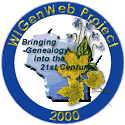

 |
Green Lake County Wisconsin USGenWeb |
 |
 |
Mackford is the southeastern town of Green lake County, boarded on the north by Green Lake, on the east by Fond du Lac County, on the south by Dodge County, and on the west by Manchester. Most of Lake Maria lies in the southwest part of this town. This lake, which extends into Manchester, covers about 600 acres. Lake Emily is near by, to the southward. Grand River flows westwardly, through the village of Markesan, through the northwestern part of the town. There is no known outlet to Lake Maria, except at very high water, when it overflows into a swale adjacent. A remarkable occurrence was the destruction of the fish in this lake during the "hard winter" of 1847. It is believed they were smothered, as the lake was entirely frozen over and the ice was covered with four feet of snow. In the spring winrows of fish were cast ashore here, all bearing evidence of this natural supposition. The greater portion of the town is prairie. The soil is one and a half to two feet deep. Good water is found in all parts of the town from six to ninety feet below the surface. Limestone crops out in places.
Name of the Town.This town derives its name from the first part of Hiram Mc Donald's name ("Mac") and a crossing place ("ford") on the river, at a point where Mr. McDonald was sanguine of building up a town. Gillespy says: "Nothing but the dog in the manger policy of some of his old neighbors prevented this place from becoming a place of business and importance-sociable, free, companionable, as well as gentlemanly, his future plans were frustrated not only to his own detriment, but the disappointment of the speculators.
Organization.
The town of Mackford was organized in 1849. At the first town meeting there were seven votes cast. "Squire" McDonald was elected Chairman; L. Wooster and John S. Toby, Supervisors; John Chapel, Justice of the Peace; J. C. Matthews, Town Clerk.
Settlement.
The first white child born in the town was John McDonald, son of Hiram McDonald. The first wedding was that of Mr. Vedder and Miss Patterson. The first death was that of a Mr. Lyon, who was killed by a tree falling upon him. The first church was built by the Presbyterians, Rev. Mr. Kaison, pastor.
Village of Markesan.
Markesan is pleasantly situated on the uneven land lying on both sides of the Grand River, in the town of Mackford on the branch of the Chicago, Milwaukee and St. Paul Railway which penetrates this county. It is seventeen miles south of Dartford and twelve miles northwest of Fox Lake, the nearest banking point.
Markesan was platted in 1849 by John Chapel and C.E. Russell, proprietors. The original plat was one and one-half miles square. Parker's addition was platted in 1858. The village was incorporated in May, 1853 and its first officers were: President, Ira Manley; Trustees, John Parker, P. Nelson, G. Harris, E.A. Wilder, M. George; Clerk, R. Lexington.
The first frame house built in the
present site of the village was erected by John B. Seward in 1844. Mr. Seward
afterward put in operation a sawmill and a gristmill which was afterward remodeled
and made a flouring mill only. The early settlers were of good stock, mostly
Yankees, but with a sprinkling of English.
The village now contains a gristmill,
a feedmill, a grain elevator, a cheese factory, carriage and wagon works, several
churches and a live weekly newspaper, the Herald, George H. Larke, editor and
proprietor. Much live stock, grain, and produce is shipped
Half a mile east of Markesan, on the Grand River, a lime-kiln was long kept running constantly. There was also a manufactory of superior kind of building material, composed principally of lime and gravelly sand. Buildings put up of this kind of composition appear to the eye, when coated with a cement or varnish used, as durable as stone, and a person unacquainted with the materials would readily believe that sandstone had been cut out to make its walls.
The Markesan Herald is in
its eight year. The publisher is George H. Larke. It is a neatly printed, newsy
sheet, well patronized by its subscribers and advertisers, and has had its influence
for good upon the development of Markesan and that portion of the country round
about. Back to GreenLakeCoWI Home Page GreenLakeCoWI Coordinator: MAKtranscriber
WIGenWeb State Coordinator: Tina Vickery
WIGenWeb Assistant State Coordinator: Marcia Ann Kuehl Complication Copyright 1996-Present - by The WIGenWeb Project Team